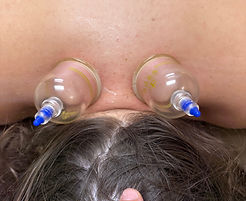Cupping Therapy: Ancient Wisdom Meets Modern Healing
What Is Cupping?
Cupping is a traditional TCM technique that uses suction to uplift the skin and superficial muscles. It boosts circulation, releases stagnation, and relieves muscle tension — both physically and energetically.
Cups may be left in place (static cupping) or moved across the muscle (moving cupping), depending on your pattern and needs. This therapy is always optional and tailored to you.
What Does It Feel Like?
Most people describe cupping as deep, soothing pressure — like an inverse massage. It can bring warmth, release, and sometimes tenderness in areas of tension.
Circular marks which may appear afterwards are not bruises — they’re signs of stagnation releasing. Expect them to fade within a few days.
Who Might Benefit?
Cupping is especially helpful for:
-
Chronic muscle tension (neck, shoulders, back)
-
Chronic or acute pain
-
Headaches, migraines
-
Cough, congestion
-
Fatigue or low energy
-
Post-illness stagnation
-
Nervous system support during stress
What Science is Showing
In plain language, research suggests:
-
Cupping increases blood flow and improves circulation.
-
It helps reduce inflammation and pain sensitivity.
-
It may trigger the release of natural pain-relieving chemicals in the body.
-
It activates the parasympathetic nervous system, encouraging deep relaxation.
Should You Try It?
Many patients report lasting relief from pain, tension, and stress—sometimes longer than what heat packs or massage offer. If you enjoy hands-on therapies and want deeper healing, cupping may be a valuable addition.
🙋♀️ Common Questions
Is it safe? Yes, when performed by a trained practitioner. We avoid areas with fragile skin, clotting issues, or open wounds.
Will I bruise? Possibly. The markings are temporary and show that circulation is returning to stagnant tissue.
How often will I need it? It depends on your condition. Some use it occasionally with acupuncture; others add it more regularly for chronic conditions.


How I Use Cupping In Practice
I don’t add cupping to every session — I use it intentionally and appropriately, just like I would with gua sha, moxa, or herbs.
I consider:
-
What pattern your body is showing
-
Whether there’s stagnation, cold, or excess tension
-
How well your body moves qi and blood
-
How cupping might support the treatment goals
Sometimes, I’ll apply cupping to support your acupuncture session
For example when:
-
A patient with asthma and a stubborn dry cough may benefit from back cupping over the lungs
-
A new mom with neck and shoulder tension might get relief with just 3 minutes of moving cups
-
A stressed professional who holds tension in their upper back might feel like their whole chest opens up
No two bodies are alike — and neither are their treatments.
You’ll always know if I plan to use it, and we’ll adjust the technique to your comfort level. Some sessions may include just a minute or two of light scraping, others a bit more focus — depending on your pattern.
🧩 More Than Muscle
While cupping absolutely helps with sore, tight muscles, that’s not its only job. It can also help with:
-
Digestive discomfort, especially when linked to stress
-
Lung support, particularly during seasonal transitions
-
Immune support during post-viral recovery
-
Emotional stagnation, especially when grief or frustration is “stuck in the chest”
Because Chinese medicine sees the body as a network of systems and energies, cupping becomes more than a physical release — it’s also a way to support your whole being.
Want To Try It?
Your body tells a story — cupping helps us read between the lines.
Cupping in classical terms
1. Nature of the Therapy
-
Cupping (bá guàn, 拔罐) is part of the external methods (外治法) in Chinese medicine.
-
It works by creating a vacuum in a glass, bamboo, or ceramic cup, which draws the skin and superficial muscle layer upward.
-
This gentle “lifting” action is seen as the opposite of massage—rather than pressing down, it draws stagnation out.
2. Main Functions in TCM Theory
-
Moves Qi and Blood – Especially useful when there is stasis from injury or overuse.
-
Dispels Wind and Cold – Often applied to the upper back and shoulders to help with early-stage colds or aches from exposure to wind/cold.
-
Opens the pores – Promotes the release of trapped pathogens from the body’s surface layer.
-
Reduces swelling and pain – By improving circulation and unblocking channels.
3. When They Reach for Cupping
-
Muscle tension or knots along the neck, shoulders, and back
-
Stubborn pain from chronic Qi and Blood stasis
-
Cough or asthma due to Cold-phlegm in the Lungs
-
Early-stage common cold with body aches
-
Recovery support for athletes after heavy training
4. Interpreting the Marks
-
In TCM, the color and speed of fading are diagnostic clues:
-
Light pink – mild stagnation
-
Dark red/purple – significant stasis or Cold accumulation
-
Brownish – old, chronic stagnation
-
-
Marks are not considered “bruises” but evidence that stagnation is being drawn to the surface.
5. The Experience
-
The cups stay on for 5–15 minutes, sometimes moved around (sliding cupping).
-
The feeling is often described as tight but relieving.
-
The goal is to leave you feeling lighter and more open in the affected area.

